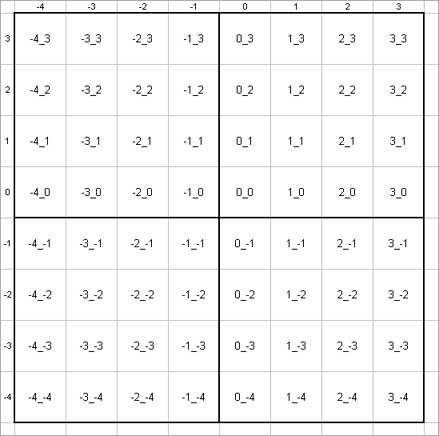Oblivion Units
Explanation[edit | edit source]
Oblivion uses a coordinate system with units which, like in Morrowind, are 21.3 'units' to a foot, or 7 units to 10 centimeters (or to put it another way 64 units per yard [~70 units per metre]). Internally the game converts from game units to centimeters by multiplying game units by 0.1428767293691635.
Another way of approximation is that any race at height 1.0 will be 128 'units' tall, and we assume that the average height of the people of Tamriel is 6 feet. 128 divided by 6 is 21+(1/3) (twenty-one and a third). Round this down, and 21 units per foot gives an average height of about 6' 1.14". This seems to be a reasonable approximation.
(Note: there is a challenge to the 21.3 units/foot conversion. An alternate conversion is 22 units/foot as established by the fMagicUnitsPerFoot game setting. See the discussion page for details)
Exterior cells measure 4096 x 4096 units or 192 x 192 feet or 58.5 x 58.5 meters. By default, the maximum distance between the player and any active object is normally between 12288 and 8192 units depending on where the object is located within a nearby cell. In interiors, the default maximum distance for active objects always remains at 12288 units (or less depending on processing). The view distance is ultimately decided by your display settings and the uGridsToLoad (default 5) value in oblivion.ini.
- These maximums can be useful when trying to figure out how long to make a cave, setting up fog so that objects are entirely within that range before they are visible, or working out how many actors you can squeeze into a city or dungeon without having to break it up into pieces.
- Activity is based on the cell containing the pivot point being loaded first, then the pivot point being within the view distance of the player. The visual mass of the object can be a large distance (more than 12288 units) away from the pivot point; in some cases this can be used to fake LOD objects in an interior if the scene allows. Object will become inactive as soon as the cell or location containing the pivot is no longer loaded.
Usage for Heightmaps
When importing height values for terrain into TESCS, 1 person height is only 64 units. Which equates to a smidge under 35 units per metre (32 units per yard). Also, the game seems to round height values down to the nearest 4 units, so this gives a vertical resolution of 5.7cm (2.25 inches). But when you load your terrain into the game, it seems to scale the height by 2 so that 64 vertical units equals 1 yard again! Confused? I certainly have been for the past couple of hours!
- Incidentally, the default water level is at 4096 units, which gets translated to 0 in the Z-axis in-game.
Here is a map of quad locations in CS editor. From the WorldBuilding 101 tutorial.
Usage Tips for Scaling and Mesh Creation
- In most cases, it is usually best to stick with multiples of 4 units when figuring out how high or large things should be.
- When figuring step heights, it is almost always better to go with a lower figure, like 18 units than it is to use something like 24 units since there are races which are smaller than 6' who might not be able to step high enough.
- When figuring ceiling heights, it is usually a good idea to have things no lower than 192 units above the floor so as to ensure passage for taller races and creatures.
- When working with any repetitive object (like walls) you should always try to make the module size a multiple of 32 units so that it is easier to piece the objects together with a grid snap. Locating key features of a mesh (like columns) centered at multiples of 8 from the insertion point of an object can also help make it easier to line up these features with clutter and lights without having to turn off grid snap and eyeball it.
Notes[edit | edit source]
- The standard spacing between nodes in a Path_Grid_Generation is 512 units, or roughly 24 feet in a square. This value is usually half when working around large objects, such as trees and boulders.
- Hand placed pathnodes which have a distance larger than 512 units between nodes may not be utilized by NPCs using wander packages.
- The quickest way to figure out units for distance calculations for packages and scripts is to create a new Light object with a given radius, turn on the light radius display, and move the light to where the location of where you need to check is located.
- These units are also used when determining the size of SubSpace.
